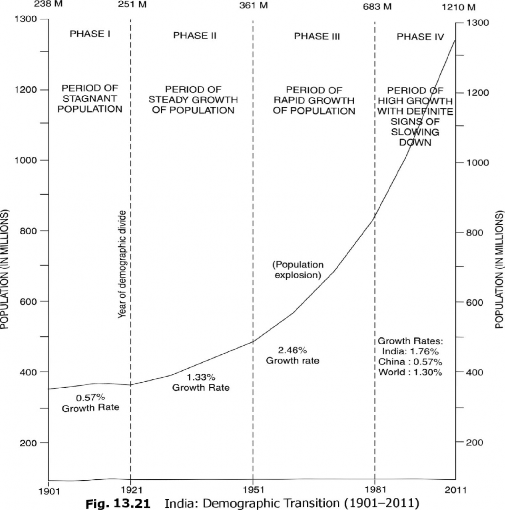2. Period of Steady Growth of Population (1921-51)
The period between 1921 and 19.51 is known as the period of steady growth of population. The birth rate during this period remained high but the death rate started to show the declining trend. Moreover, some of the epidemic diseases like cholera, malaria, plague, small pox were significantly controlled. The problems of scarcity of food were also controlled with the help of the expansion and improvements in the roads and railways networks.

Table 13.7 India—Birth Rate, Death Rate, and Natural Growth Rate of Population (1911-2011)
Census Year | Crude B irth Rate | Crude Death Rate | Natural Growth Persons Per Thousand oj Population |
1911 | 49 | 43 | 6 |
1921 | 48 | 47 | 1 |
1931 | 46 | 36 | 10 |
1941 | 45 | 31 | 14 |
1951 | 40 | 27 | 13 |
1961 | 42 | 23 | 19 |
1971 | 37 | 15 | 22 |
1981 | 34 | 12 | 22 |
1991 | 31 | 11 | 20 |
2001 | 26 | 9 | 17.7 |
2011 | 23 | 5.4 | 17.6 |
Source: Census of India, 2011.
It may be seen from Table 13.7 that the natural growth rate of population was the highest between 1961-71 and 1971-81, being 22 persons per thousand of population. In 2001, the natural growth of population declined to 17 persons per thousand which is an encouraging factor for the demographers and population planners. In fact, 2001-2011 is the first decade (with the exception of 1911-1921) which has actually added lesser population compared to the previous decade. The absolute growth of population is still significantly high being about 20 million per year which is mainly because of the large base (over one billion) of population of India.
At present India is in a state of rapid fertility transition with the pace of decline having accelerated in recent years. India’s population is in the late expanding
stage in which birth rate is falling, death rate is also falling and population continues to grow. This is because of: (i) family planning, (ii) lower infant mortality,
(iii) changing status of women and (iv) increase in standard of living. The pace of decline varies from state to state and experiences of Andhra Pradesh, Nagaland, Goa, Tamil Nadu, W. Bengal, Assam, Tripura, Odisha, and Kerala indicate that the Crude Birth Rate (CBR) can go much below the replacement level of fertility. The rural urban differential in fertility tend to narrow down as fertility declines. In Nagaland, Kerala, Tamil Nadu, Andhra Pradesh, and Goa, the rural urban birth rates are almost the same. There is greater homogeneity in the Crude Birth Rate in urban areas compared to rural areas. Surprisingly, among the larger high fertility states of north India, Bihar has exhibited a comparatively rapid decline in the Crude Birth Rate during the last ten years, probably as a result of relatively greater acceptance of family planning methods. Interestingly enough, Nagaland recorded the lowest growth rate of 0.47 per cent during the decade of 2001-2011.
